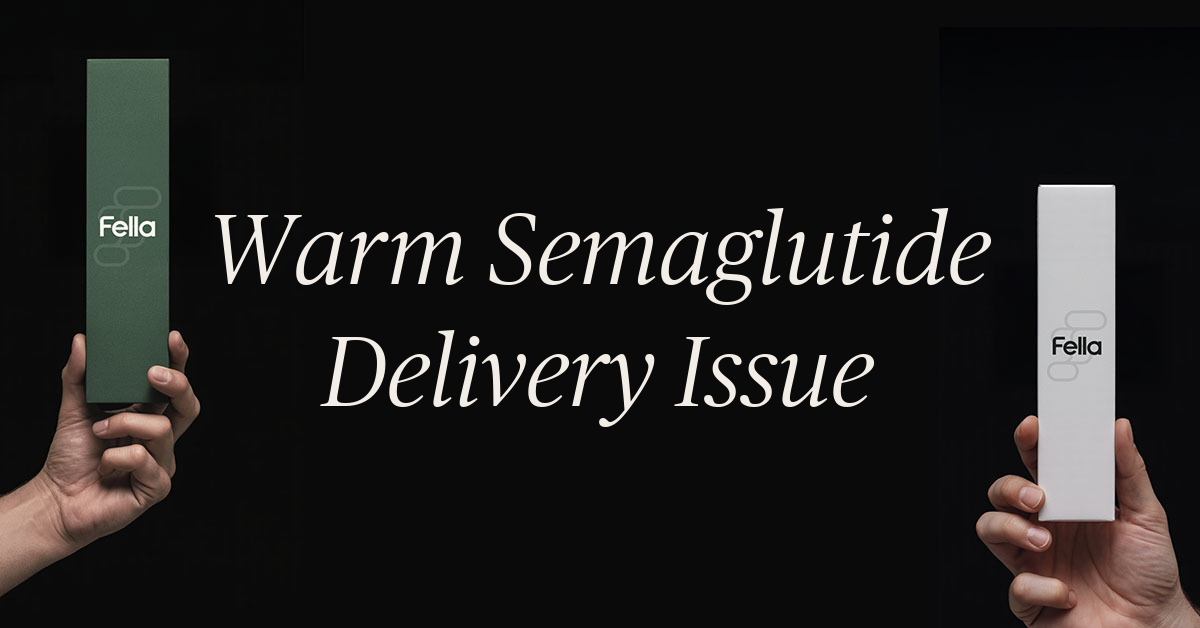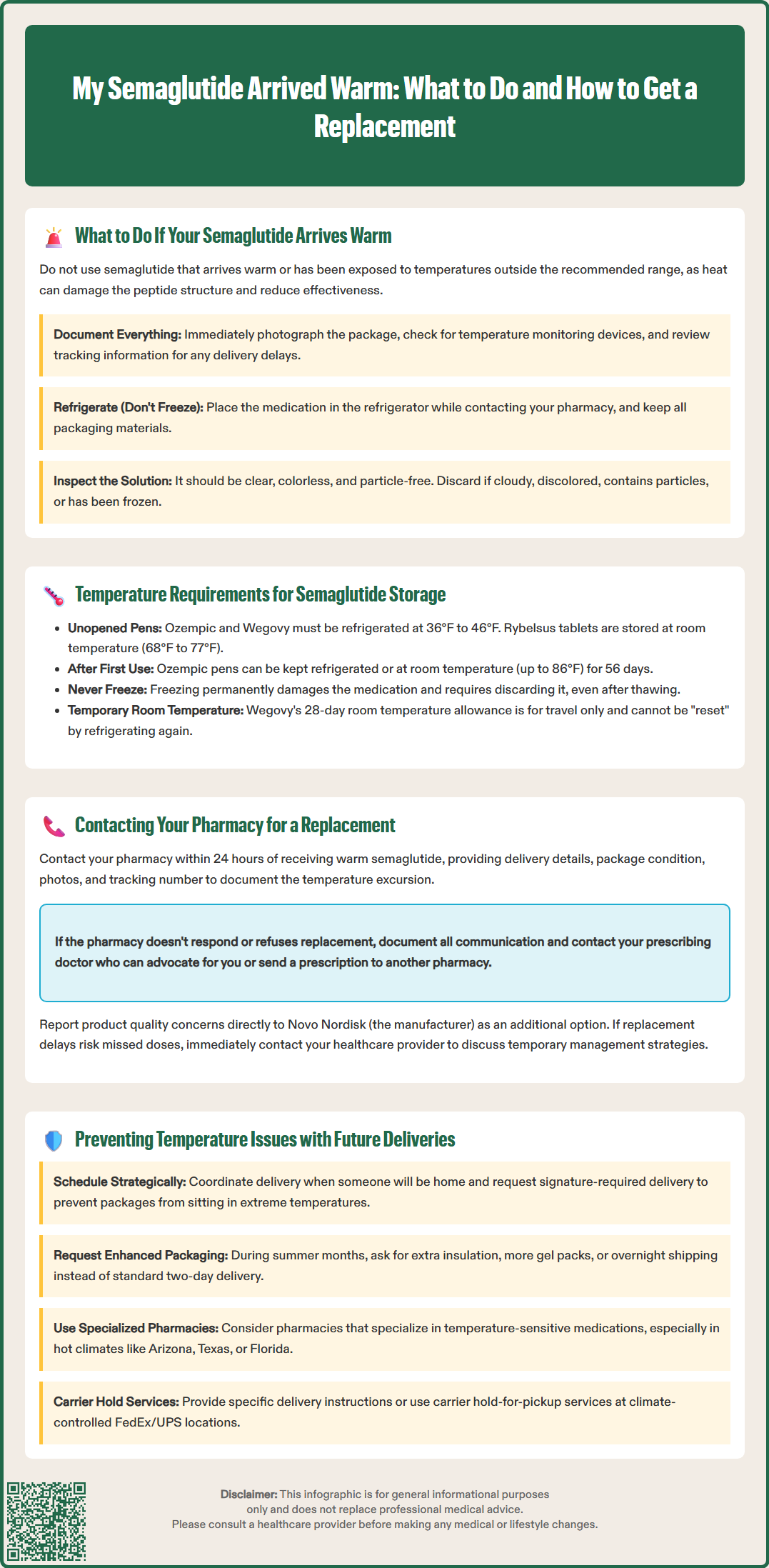LOSE WEIGHT WITH MEDICAL SUPPORT — BUILT FOR MEN
- Your personalised programme is built around medical care, not willpower.
- No generic diets. No guesswork.
- Just science-backed results and expert support.
Find out if you’re eligible

Receiving semaglutide that arrives warm can be concerning, as this temperature-sensitive medication requires specific storage conditions to maintain its effectiveness and safety. Semaglutide is a glucagon-like peptide-1 (GLP-1) receptor agonist used for type 2 diabetes and weight management, and exposure to elevated temperatures during shipping may compromise its therapeutic properties. If your package feels warm upon delivery or shows signs of temperature excursion, do not use the medication. Instead, document the condition, contact your pharmacy immediately, and store the product in your refrigerator while awaiting guidance. Understanding proper storage requirements and replacement procedures helps ensure you receive effective medication and avoid treatment interruptions.
Quick Answer: If semaglutide arrives warm, do not use it—refrigerate the medication, document the package condition with photos, and contact your pharmacy within 24 hours for a replacement.
If your semaglutide arrives warm to the touch or has been exposed to temperatures outside the recommended range, do not use the medication immediately. Semaglutide is a temperature-sensitive glucagon-like peptide-1 (GLP-1) receptor agonist that requires specific storage conditions to maintain its structural integrity and therapeutic efficacy. Exposure to elevated temperatures can denature the peptide structure, potentially reducing effectiveness or altering the safety profile.
Upon receiving a warm package, first check the packaging for any temperature monitoring devices, such as temperature indicators or data loggers, which some specialty pharmacies include with temperature-sensitive biologics. Document the condition of the package with photographs, noting any visible damage, delivery time, and transit delays. Check your tracking information to determine how long the package was in transit.
Immediate steps include: placing the medication in your refrigerator (not freezer) while you contact the dispensing pharmacy, retaining all packaging materials and documentation, and avoiding any use of the product until you receive guidance from your pharmacist or healthcare provider. Do not attempt to "test" the medication by administering a dose, as compromised semaglutide may not provide adequate glycemic control.
For injectable semaglutide (Ozempic, Wegovy), visually inspect the solution, which should be clear, colorless, and free of particles. Do not use if the solution appears cloudy, discolored, contains particles, or has been frozen and then thawed.
The FDA-approved prescribing information for semaglutide products specifies proper storage requirements. For additional guidance, you can also contact the manufacturer (Novo Nordisk) directly with product quality concerns in addition to consulting your pharmacy or healthcare provider.
Semaglutide formulations have specific temperature requirements that differ by product and between unopened and in-use status.
Ozempic (injectable semaglutide): Unopened pens must be stored refrigerated at 36°F to 46°F (2°C to 8°C). After first use, pens may be stored either refrigerated or at room temperature (up to 86°F/30°C) for up to 56 days. Always store with the pen cap on to protect from light.
Wegovy (injectable semaglutide): Unopened pens must be stored refrigerated at 36°F to 46°F (2°C to 8°C). If needed, unopened pens may be kept at room temperature (up to 86°F/30°C) for up to 28 days. Wegovy pens are single-use only and should be discarded after use.
Rybelsus (oral semaglutide): Store at room temperature between 68°F to 77°F (20°C to 25°C), with excursions permitted between 59°F to 86°F (15°C to 30°C). Keep tablets in the original bottle with the desiccant and the bottle tightly closed to protect from moisture. Do not store in pill organizers.
All semaglutide products should never be frozen; freezing denatures the peptide structure and renders the product unusable. If a product has been frozen, it must be discarded even if it subsequently thaws.
The 28-day room temperature allowance for Wegovy is intended for patient convenience during travel or temporary storage situations, not as a substitute for proper refrigerated storage during shipping and long-term storage. Once this room temperature window is used, it cannot be "reset" by returning the pen to refrigeration.
Temperature excursions during shipping represent a particular concern because the duration and degree of temperature elevation are unknown. While pharmaceutical manufacturers conduct stability testing under various conditions, uncontrolled exposure during shipping—particularly during summer months or in hot climates—may affect product quality. Always inspect injectable solutions before use; they should be clear, colorless, and free of particles.

When semaglutide arrives warm, prompt communication with your dispensing pharmacy is essential to obtain a replacement and prevent treatment interruption. Many pharmacies, particularly those specializing in temperature-sensitive biologics, have established protocols for handling temperature excursions during shipping. Contact the pharmacy within 24 hours of delivery to report the issue while the shipping timeline is still documented.
When calling, provide specific information including: the date and time of delivery, the condition of the package upon arrival (warm to touch, damaged insulation, melted ice packs), any temperature monitoring data if included, your tracking number, and photographs of the packaging. Ask the pharmacy about their temperature excursion policy and replacement procedures. Some specialty pharmacies may have shipping records that include temperature data, which can help determine the extent of temperature exposure.
Pharmacy responses may include: initiating a replacement shipment (policies regarding costs vary by pharmacy, insurer, and manufacturer), providing expedited shipping for the replacement, investigating the shipping failure with their courier service, and potentially modifying future shipping methods (such as requiring signature upon delivery or using enhanced temperature-controlled packaging). Some pharmacies may request that you return the compromised medication, while others may instruct you to dispose of it properly according to FDA guidelines for medication disposal.
If your pharmacy is unresponsive or unable to replace temperature-compromised medication, document all communication attempts and contact your prescribing healthcare provider. Your provider can advocate on your behalf, contact the pharmacy directly, or send a new prescription to an alternative pharmacy if necessary. For patients using insurance or manufacturer savings programs, ask whether the replacement will affect your allowed refills or require additional prior authorization.
You can also contact Novo Nordisk (the manufacturer) directly with product quality concerns. If you are unable to obtain a timely replacement and are at risk of missing doses, contact your healthcare provider immediately to discuss interim management strategies for your diabetes or weight management plan.
Proactive measures can significantly reduce the risk of temperature-related damage to future semaglutide shipments. Communicate with your pharmacy before each shipment to discuss delivery timing and temperature considerations. Request delivery on days when you or a trusted individual will be home to receive the package immediately. Many specialty pharmacies offer delivery notifications via text or email, allowing you to track the package in real-time and retrieve it promptly upon arrival.
Consider requesting signature-required delivery to ensure the package is handed directly to a person rather than left unattended. This is particularly important during summer months or in regions with extreme temperatures. Some pharmacies offer specific delivery windows or allow you to designate alternative delivery locations, such as a workplace with climate-controlled receiving areas. If you live in an apartment building, coordinate with building management to ensure packages are not left in uncontrolled environments.
Seasonal considerations are critical for temperature-sensitive medications. During summer months (typically June through September in most US regions), discuss enhanced packaging options with your pharmacy. This may include additional insulation, larger quantities of refrigerant gel packs, or expedited overnight shipping rather than standard two-day delivery. Consider scheduling refills during cooler months when temperature control is more manageable, if your coverage allows.
For patients in particularly hot climates (such as Arizona, Texas, or Florida), consider using pharmacies that specialize in temperature-sensitive biologics and have robust cold-chain logistics. These pharmacies typically use validated shipping containers with temperature monitoring devices and have established protocols for extreme weather conditions. Some offer local pickup options, eliminating shipping risks entirely.
Additional preventive strategies include: planning refills to avoid holiday periods when shipping delays are common, providing detailed delivery instructions (such as "leave package inside screen door" or "deliver to side entrance in shade"), requesting carrier hold-for-pickup at staffed, climate-controlled FedEx/UPS locations, choosing pharmacy pickup when available, and maintaining open communication with your pharmacy about any delivery issues to help them improve their processes. Developing contingency plans for supply interruptions, including knowing alternative pharmacy options and maintaining communication with prescribing providers, is recommended for patients taking temperature-sensitive medications.
No, do not use semaglutide that arrived warm. Temperature exposure may compromise the medication's effectiveness and safety. Refrigerate the product and contact your pharmacy immediately for guidance and a replacement.
Unopened semaglutide should remain refrigerated at 36°F to 46°F. While Wegovy allows up to 28 days at room temperature (up to 86°F) if needed, uncontrolled temperature exposure during shipping is problematic because the duration and degree of heat exposure are unknown.
Most specialty pharmacies have protocols for replacing temperature-compromised medications, though policies vary by pharmacy, insurer, and manufacturer. Contact your pharmacy within 24 hours with documentation to initiate the replacement process.
All medical content on this blog is created using reputable, evidence-based sources and is regularly reviewed for accuracy and relevance. While we strive to keep our content current with the latest research and clinical guidelines, it is intended for general informational purposes only.
This content is not a substitute for professional medical advice, diagnosis, or treatment. Always consult a licensed healthcare provider with any medical questions or concerns. Use of this information is at your own risk, and we are not liable for any outcomes resulting from its use.